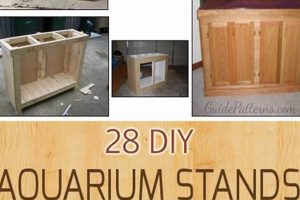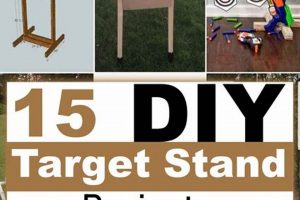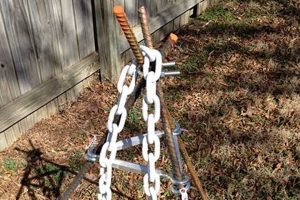A self-constructed, upright support for a computer display provides an alternative to commercially available horizontal orientations. This custom fabrication allows users to tailor the display’s positioning to suit specific ergonomic or spatial requirements. For example, individuals might create such a structure from wood, metal, or repurposed materials to elevate a screen vertically.
The advantages of raising a screen into a vertical position include enhanced desk space utilization and potential improvements to user posture, which may reduce neck and back strain. The concept has gained traction with the rise of multi-display setups and the increasing awareness of ergonomic workplace design. Historically, modifications to standard equipment have been driven by needs unmet by mass-produced solutions.
The subsequent sections will delve into material selection, design considerations, construction techniques, and potential safety measures for building a personal upright display mount. This exploration aims to provide a comprehensive guide for those considering this approach.
Construction Guidelines for an Upright Display Support
The following guidelines offer practical advice for individuals undertaking the fabrication of a personalized, vertically oriented display mounting solution. Adherence to these recommendations promotes both structural integrity and user safety.
Tip 1: Material Selection: Prioritize materials with adequate load-bearing capacity. Wood, steel, or aluminum represent viable options, contingent upon the display’s weight and dimensions. Ensure compatibility between chosen materials if employing a hybrid construction.
Tip 2: Accurate Measurements: Precise measurements of the display’s mounting points are crucial. Consult the display’s specifications or user manual to determine VESA (Video Electronics Standards Association) compatibility and hole patterns. Inaccurate measurements may compromise stability.
Tip 3: Ergonomic Considerations: Before finalizing the design, assess the ideal viewing height and angle. The top of the screen should generally be at or slightly below eye level. Adjustment mechanisms may be incorporated to accommodate variable user preferences.
Tip 4: Stability Augmentation: Implement measures to enhance stability, such as a broad base or counterweights. The structure should resist tipping or wobbling, particularly when the display is positioned at its maximum extension.
Tip 5: Cable Management: Integrate channels or clips to facilitate organized cable routing. Unmanaged cables can detract from the aesthetic appeal and pose a safety hazard. Ensure adequate slack to prevent strain on connectors.
Tip 6: Safety Fasteners: Employ appropriate fasteners (screws, bolts, adhesives) designed for the selected materials. Confirm the fasteners’ load-bearing capacity and compatibility with the mounting surfaces. Regular inspection is recommended to detect any loosening or degradation.
Tip 7: Structural Reinforcement: Depending on the complexity of the design, consider incorporating structural reinforcements, such as gussets or bracing. These additions will enhance the overall rigidity and prevent deformation under load.
Implementing these recommendations will lead to a more stable, ergonomic, and aesthetically pleasing outcome. Careful planning and execution are essential for a successful project.
The concluding section will summarize the key considerations and highlight the long-term benefits of this individualized solution.
1. Stability
Stability is a paramount attribute of any self-constructed, upright display support. It directly influences user safety and the longevity of the attached monitor. An unstable structure poses a risk of tipping, potentially causing damage to the display and surrounding objects. Furthermore, even minor instability, such as wobbling, can induce visual fatigue and detract from the overall user experience. Constructing a stable solution requires careful consideration of the base’s dimensions, the material’s load-bearing capacity, and the distribution of weight.
Practical applications of stability principles include widening the base of the vertical support to increase its resistance to tipping forces. Employing thicker materials, such as steel or reinforced wood, also enhances structural integrity. Counterweights strategically positioned at the base can further improve balance, especially when using heavier monitors. Real-world examples of instability leading to adverse outcomes highlight the importance of rigorous testing and reinforcement during the building process. A structure crafted from lightweight materials with a narrow base is demonstrably more prone to collapse under minimal external forces.
In summary, stability is not merely a desirable characteristic but a fundamental requirement for a successful and safe. Achieving adequate stability necessitates a comprehensive assessment of material properties, structural design, and weight distribution. Prioritizing stability mitigates potential risks, enhances user comfort, and ensures the prolonged functionality of the custom-built display mount.
2. Adjustability
Within the context of self-constructed, vertically oriented display supports, adjustability provides a mechanism for tailoring the viewing experience to individual ergonomic requirements and task-specific needs. The capacity to modify the screen’s position dynamically enhances user comfort and promotes efficient workflow, particularly for individuals engaged in prolonged periods of screen-based activity. Inherent limitations in commercially available monitor stands often motivate individuals to pursue personalized, adjustable solutions.
- Height Adjustability
Vertical displacement of the display offers the capability to align the screen with the user’s eye level, mitigating neck strain and promoting proper posture. For example, a user alternating between sitting and standing positions may require a wide range of height adjustment. Inadequate height adjustability necessitates compensatory postural adaptations, potentially leading to musculoskeletal discomfort.
- Tilt Adjustability
The ability to incline the display screen forward or backward optimizes viewing angles and reduces glare from ambient light sources. A user experiencing glare may benefit from tilting the screen downward to minimize reflections. Insufficient tilt adjustability can force users to adopt awkward viewing positions or resort to external anti-glare solutions.
- Swivel Adjustability
Horizontal rotation of the display allows for convenient screen sharing or adaptation to varying desk configurations. A user collaborating with colleagues may swivel the display to facilitate group viewing. Limited swivel adjustability restricts the display’s effective viewing area and may necessitate physical repositioning of the entire structure.
- Pivot Adjustability
Rotation of the display between landscape and portrait orientations provides flexibility for different application requirements. Software developers, for instance, may prefer portrait orientation for viewing long lines of code. Lack of pivot adjustability limits the versatility of the display and restricts its applicability to specific tasks.
These facets of adjustability collectively contribute to a personalized and ergonomic viewing experience. While fixed-position structures may offer a cost-effective solution, the absence of adjustability compromises user comfort and potentially reduces productivity. A custom-built, adjustable design allows for seamless integration of the display into diverse work environments and accommodation of individual user preferences, making it a worthwhile consideration.
3. Material Strength
Material strength constitutes a foundational consideration in the design and construction of self-assembled, upright display supports. The structural integrity of the mount, its ability to bear the monitor’s weight, and its resistance to deformation under sustained load are all directly contingent upon the selected materials’ inherent mechanical properties. Insufficient material strength can result in catastrophic failure, posing a risk to the monitor and surrounding environment.
- Tensile Strength
Tensile strength dictates a material’s ability to withstand pulling forces without fracturing. In the context of a vertically oriented display mount, tensile strength is crucial for resisting the gravitational force exerted by the monitor. For example, a steel support member possesses significantly higher tensile strength than a comparable wooden component, making it a more suitable choice for supporting heavier displays. Failure to account for tensile strength can lead to gradual elongation of the support structure, ultimately resulting in instability and potential collapse.
- Compressive Strength
Compressive strength defines a material’s capacity to resist forces that tend to reduce its volume. In a vertical display mount, the vertical support elements are primarily subjected to compressive forces. Concrete, for instance, exhibits high compressive strength, rendering it suitable for constructing a stable base. However, relying solely on a material with high compressive strength while neglecting other mechanical properties can lead to localized failures, such as crushing under concentrated loads.
- Yield Strength
Yield strength represents the stress at which a material begins to deform permanently. Exceeding a material’s yield strength in a display mount application can result in irreversible bending or twisting of the support structure. For example, an aluminum arm subjected to excessive weight may permanently deform, compromising its ability to maintain the desired display orientation. Consequently, selecting materials with adequate yield strength, particularly for load-bearing components, is paramount.
- Shear Strength
Shear strength measures a material’s resistance to forces that cause it to slide or deform along a plane. In a self-built monitor support, shear strength is crucial in fastener connections, such as bolted joints. A poorly designed joint with inadequate shear strength may fail under load, leading to separation of components and potential instability. Therefore, selecting appropriate fasteners and ensuring sufficient material shear strength around connection points are essential for overall structural integrity.
The interrelation between tensile, compressive, yield, and shear strength collectively determines the suitability of a material for constructing a secure and reliable upright display mounting system. A holistic evaluation of these properties, coupled with accurate load calculations, is essential for ensuring long-term performance and minimizing the risk of structural failure. For example, substituting a high-density particleboard with a low-carbon steel will likely increase the lifespan of a diy monitor stand because it has higher level in those four material strength, leading to more stability.
4. Cable Management
Effective cable management is an indispensable aspect of any self-constructed, upright display support. A disorganized cable arrangement not only detracts from the aesthetic appeal of the setup but also presents potential safety hazards and operational impediments. Consequently, meticulous attention to cable routing and organization is paramount when undertaking a project of this nature.
- Safety Considerations
Unmanaged cables trailing across a workspace constitute a tripping hazard, potentially leading to personal injury and damage to equipment. Furthermore, tangled cables can impede access to power outlets and other essential connections. A well-organized cable management system mitigates these risks by securely routing cables away from walkways and work surfaces. For instance, utilizing cable sleeves or channels to bundle and conceal wires reduces the likelihood of accidental entanglement or disconnection. Neglecting these precautions increases the probability of workplace accidents and equipment damage.
- Aesthetic Enhancement
A clutter-free workspace promotes a sense of professionalism and efficiency. Tangled or haphazardly arranged cables create a visually distracting environment, detracting from the overall appearance of the self-constructed display support. Conversely, a well-executed cable management system contributes to a clean and organized aesthetic. Incorporating features such as integrated cable routing channels within the support structure or employing cable ties to neatly bundle wires enhances the visual appeal of the setup. Prioritizing aesthetic considerations elevates the perceived value and functionality of the entire system.
- Ergonomic Benefits
Improperly managed cables can interfere with ergonomic adjustments, such as height or tilt adjustments of the display. Cables that restrict movement can create strain on connectors and potentially damage connected devices. A well-designed cable management system allows for unrestricted adjustment of the display without compromising cable integrity or creating obstructions. Implementing flexible cable routing solutions, such as articulating arms with integrated cable channels, ensures that cables move freely with the display, minimizing strain and maximizing ergonomic flexibility.
- Operational Efficiency
Simplified cable identification and access facilitate troubleshooting and maintenance. Untangling a mass of wires to locate a specific connection can be time-consuming and frustrating. A well-labeled and organized cable management system streamlines the process of identifying and accessing individual cables. Employing color-coded cable ties or labels allows for quick and accurate identification, reducing downtime and improving operational efficiency. Investing in a robust cable management system reduces the time and effort required for routine maintenance and troubleshooting tasks.
In summary, effective cable management is an essential component of a successful self-constructed, upright display support. Addressing safety concerns, enhancing aesthetics, promoting ergonomic flexibility, and improving operational efficiency are all directly contingent upon the implementation of a well-designed cable management system. Neglecting this aspect can compromise the overall functionality and longevity of the entire setup, highlighting the importance of meticulous planning and execution.
5. VESA Compliance
VESA (Video Electronics Standards Association) compliance is a critical consideration when designing and constructing a self-made, vertically oriented display support. This standard ensures compatibility between the display and its mounting interface, facilitating secure attachment and preventing potential damage to the equipment.
- Standardized Mounting Patterns
VESA establishes standardized hole patterns on the back of monitors and televisions, measured in millimeters (e.g., 75x75mm, 100x100mm). Adhering to these standardized patterns in a construction allows for universal compatibility. If a build deviates from these standards, attachment may be impossible without modification. The absence of a VESA-compliant mounting interface forces reliance on proprietary mounting solutions or custom fabrication, potentially increasing complexity and cost. For example, constructing a mount with a 100x100mm pattern allows for compatibility with a wide range of displays.
- Load Capacity Considerations
VESA standards often specify maximum weight limits for each mounting pattern. Exceeding these limits can compromise the structural integrity of the mount and potentially cause the display to detach. For a self-built mount, the selected materials and construction techniques must adequately support the display’s weight, adhering to the established VESA guidelines. Ignoring this aspect could result in structural failure, jeopardizing the equipment and potentially causing injury. For instance, a lightweight plastic mount supporting a heavy monitor is likely to fail over time, whereas a steel mount built to the specifications outlined for the specific VESA pattern maintains structural integrity.
- Screw Specifications
VESA standards prescribe specific screw sizes, lengths, and thread types for securing the display to the mount. Using incorrect screws can damage the display’s internal components or result in an insecure attachment. Self-builders must adhere to these specifications to ensure a safe and reliable connection. Failure to use the correct screws may strip the mounting holes or exert undue stress on the display’s chassis. For example, using screws that are too long can puncture internal components, while screws that are too short may not provide sufficient holding force.
- Accessibility and Ease of Installation
VESA compliance facilitates straightforward installation and removal of the display. The standardized mounting patterns and screw specifications simplify the process of attaching and detaching the monitor from the mount. A custom-built mount that deviates from VESA standards may require specialized tools or techniques for installation, increasing complexity and potentially damaging the display. Compliance minimizes the effort required for setup and maintenance. A monitor designed with a VESA mount and a corresponding compatible design greatly increases convenience.
Therefore, VESA compliance is not merely a recommendation but a functional necessity for ensuring a secure, reliable, and user-friendly self-built display mounting. Adhering to VESA standards facilitates universal compatibility, simplifies installation, and minimizes the risk of damage to the equipment or injury to the user. For example, a person that designs their build to meet the VESA guideline will likely see an increase in stability as well as ease of use for changing monitors.
Frequently Asked Questions
The following section addresses common inquiries and concerns pertaining to the design, construction, and implementation of personalized, vertically oriented display mounting solutions.
Question 1: What are the primary advantages of utilizing a vertically oriented display?
A vertically oriented display configuration can maximize desk space utilization, improve ergonomic posture by promoting a more natural neck alignment, and facilitate the viewing of vertically formatted content such as code, documents, or social media feeds.
Question 2: What safety precautions should be observed during the construction process?
Proper safety eyewear, gloves, and respiratory protection are essential when working with power tools and materials that generate dust or fumes. Ensure adequate ventilation and follow all manufacturer’s instructions for tools and adhesives. Securing components adequately is critical to prevent collapse.
Question 3: What materials are most suitable for constructing a durable and stable structure?
Steel, aluminum, and hardwood offer robust load-bearing capabilities. The selection should reflect the monitor’s weight and dimensions, as well as the desired aesthetic. Pressure treated lumber should be avoided due to off-gassing.
Question 4: How is VESA compliance ensured when building a custom mount?
Consult the display’s specifications to determine the VESA mounting pattern (e.g., 75x75mm, 100x100mm). Precisely measure and replicate this pattern on the mount, utilizing appropriate fasteners of the specified diameter and length. Templates can be found online.
Question 5: How can cable management be effectively integrated into a stand design?
Incorporate channels, clips, or sleeves to route and conceal cables along the support structure. Ensure sufficient slack to accommodate display adjustments. Utilize cable ties or Velcro straps to bundle wires neatly.
Question 6: What provisions should be made for adjusting the display’s height and angle?
Implement adjustable mechanisms such as telescoping tubes, hinged joints, or sliding brackets to facilitate customized positioning. Secure locking mechanisms are essential to maintain the selected settings.
Effective design and construction, attention to safety protocols, and adherence to VESA standards are paramount to achieving a functional and safe vertical display solution.
The subsequent section will provide concluding remarks, summarizing the key benefits and considerations.
Conclusion
This exploration has detailed critical aspects of the self-construction of an upright display support. Stability, adjustability, material strength, cable management, and VESA compliance constitute essential factors for ensuring both functionality and safety. Neglecting any of these core principles can result in an unstable, ergonomically unsound, or structurally compromised assembly. Meticulous attention to design, material selection, and construction techniques is therefore paramount.
The decision to fabricate a personalized upright display support should stem from a clear understanding of the requisite skills, resources, and potential risks. If thoughtfully executed, this approach provides a customizable solution that can enhance workspace ergonomics and efficiency. However, rigorous adherence to safety protocols and established engineering principles remains non-negotiable to mitigate potential hazards and ensure long-term operational integrity.



![Build a Better DIY Table Saw Stand [Plans & Guide] The DIY Hub: Creative Crafts, Repairs & Life Hacks Build a Better DIY Table Saw Stand [Plans & Guide] | The DIY Hub: Creative Crafts, Repairs & Life Hacks](https://craftingdiycenter.com/wp-content/uploads/2025/07/th-3315-300x200.jpg)



